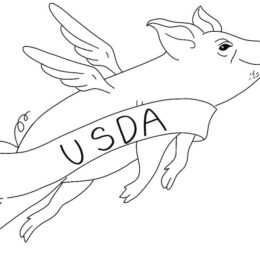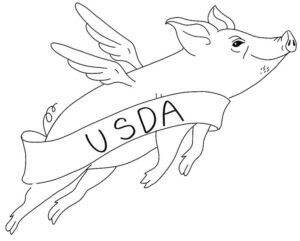“Pigs Can Fly” According to USDA Study
Doesn’t appear much is changing at USDA …
Secretary Rollins, ask those boys if they favor: M-COOL, pushing back on mandatory E-ID, checkoff reform, & competition reform. Majority of ranchers support these things. If you want to find out what ranchers really want/need, meet with R-CALF USA………@dhydefarm @EricGropper… https://t.co/00ib0Ojinx
— Eric Nelson (@seedcattleguy) March 27, 2025
Hoping Secretary Rollins will begin a conversation with producers of livestock. We’ve been at this battle for a long time and continue to lose.
Here’s some history:

May 7, 1999 FOR IMMEDIATE RELEASE
‘Pigs Can Fly’ According to USDA Study
Saying “Pigs can fly” is the same as saying, “U.S. meat packers didn’t depress prices,” which is what the USDA wants us to believe. And for those of you who have continued to wrongfully perceive that packer’s practices aren’t the reasons for low livestock prices, you must believe that trees don’t grow in the forest and there is no water in the ocean.
Even Hitler would have been proud of the land-grant university economists who conducted the 1996 Concentration in Agriculture study and the in-house USDA economists who this week released their preposterous peer review of the 1996 study and agreed that “the big meat packers didn’t depress prices. “
It was he who said, “The bigger the lie, the easier it is for the public to swallow.” The USDA study has given us the big lie.
With this announcement and virtual “green light” from USDA to continue their exploitation of cattlemen, the packers quickly bid lower money for live cattle this week, at the same time as beef cutouts justified higher cattle prices. Compared to one year ago, USDA data shows the packer is making $83.73 more per head on a finished 1200-pound steer while cattlefeeders continue to go broke.
Ironically, all this after last week’s successful class action ruling against IBP in a case claiming anti-competitive practices, and IBP’s announcement of record quadruple first quarter earnings. In an interview, IBP stated, “It makes no sense for us to do anything to hurt cattle producers, when we depend on them to supply our plants.” The IBP spokesman went on to say, “It is discouraging to be portrayed as a villain when study after study have found that depressed market prices are due to basic supply and demand, not meatpacking concentration or captive supply.” This is another big lie. The pigs are flying at IBP.
One leading economist stated the following, “This USDA study is negligently misleading. No relevant conclusions regarding the illegal exercise of market power can be reached, given the annual data used in this study. The illegal exercise of market power is not only a question of law (not economics) but also a question of the daily behavior of market participants, which in no way is analyzed by this study based on annual data (one observation per year).”
Unbelievably, IBP’s friends at USDA verified the “study after study” argument this week despite their full knowledge of IBP’s 122% captive supplies during the devastating, nearly $200 per head market drop of 1994. Despite their full and complete access to court records showing that during the sixty-four week period studied, the cash market fell two out of three times when IBP was forced to buy cash cattle.
FACT: USDA has continued to ignore the day that ConAgra sold 7250 head of cattle to their partner in crime, IBP, exploding the floodgates on the weeks cattle trade and breaking the cash market sixty dollars per head from cattle feeder asking prices.
FACT: USDA has in their hands, since January 1999 clear evidence of price discrimination, undue preference and feedyard blackballing and still they say, “U.S. meat packers didn’t depress prices.”
FACT: USDA overlooked their own recent indictment of Cargill for cheating pork producers. How about seven cent hogs and the corresponding record meat packer profits?
What makes USDA and their land-grant university touts so blind to the obvious? Could it be the money and the power of the multinational corporate predators IBP, ConAgra and Cargill have captured this government agency?
Doesn’t the next investigation need to be of the USDA?

